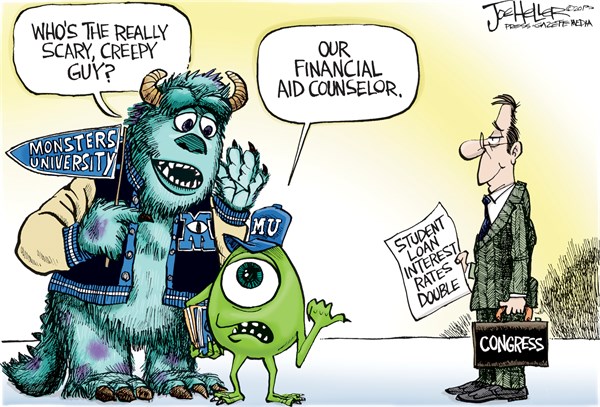federal loan program
New changes in the Federal Education Loan Scheme spell Mixed Reactions
Student loan borrowers across USA have a decent incentive available for them. The President of United States announced some important changes in the Federal loan system. Even as the amendments have been introduced into the federal student loans forgiveness program, there are thousands, if not millions of probable borrowers who did not understand the meaning of the changes and how they will be beneficial for them.
The actual implementation of the changes made to the federal student loans forgiveness may or may not live up to the expectations of the borrowers unless properly communicated. The Education Department is likely to launch a new initiative to educate as many borrowers as possible before moving ahead with the fresh list of changes in end-2016.
Key pointer related to the student loan forgiveness program
– Expansion in Pay As Your Earn
President Obama expanded the span of the program called the Pay As You Earn. The executive decision will now allow the federal loan borrowers to balance out their monthly caps like in income-based repayment scheme. As of now, the Pay as You Earn scheme is capped at 10 per cent of the borrower’s disposable income. The incentive of the Obama Student Debt Forgiveness applies its pardon after 20 years of continuous payment of the monthly interest. The new borrowers will be capped under this new change. Old borrowers will continue to be capped at 15 per cent and would earn forgiveness only after 25 years.
– Coverage depends on the year of loan sanctioning
If the federal student loans were sanctioned before October 2007 and those who stopped borrowing by October 2011 would be covered under the Obama Student Debt Forgiveness as per the new changes of Pay as You Earn Scheme. The estimated number of borrowers under the scheme could reach anywhere between 5 million and 5.5 million.
– Savings expected with new changes
The borrowers will save a lot of money if they seek federal loans for education now. Income-based repayment and Pay as You Earn are different plans but are designed around the same premise of extending fullest support to the borrowers. The difference in repayment sum through the two palns could range between USD 8,500 to USD 16,900. The current interest rate is around 3.41 per cent. The estimates in savings have been made for a federal loan borrower who has an annual income of USD 35,000 + with number of dependents limited to four family members.

– Means to consolidate Federal student loans
The senate recently proposed the Bank of Students Emergency Loan Refinancing Act. The new legislation will be clubbed with the Debt forgiveness program so that federal as well as the private student loan borrowers can consolidate student loans under Direct Loan Program. The borrowers can club loans with higher interest rates with the federal student loans available at lower fixed interest rates.
The proposed changes to the scheme are likely to put undue pressure on the tax payers but in the long run will cut out all education-related debts staring at the treasury.
The Scary Side of Student Debt
Defaulting on your loans can ruin your financial life. Here are some good strategies to avoid or repair the damage.
 Imagine going to college to improve your life and walking away with $500,000 in student debt. That number is no typo. A young Seattle couple ended up so mired in debt on the way to their degrees that they “couldn’t even make the initial payments,” says Christina Henry, of Seattle Debt Law. After the collection agencies started calling, the couple, who have two children and earn a total of $80,000, visited Henry for help. “They took out as much as they were able to and didn’t even know how much they had. It’s the most egregious case I’ve ever seen.”
Imagine going to college to improve your life and walking away with $500,000 in student debt. That number is no typo. A young Seattle couple ended up so mired in debt on the way to their degrees that they “couldn’t even make the initial payments,” says Christina Henry, of Seattle Debt Law. After the collection agencies started calling, the couple, who have two children and earn a total of $80,000, visited Henry for help. “They took out as much as they were able to and didn’t even know how much they had. It’s the most egregious case I’ve ever seen.”
Consider it a cautionary tale. Over the past decade, college students have had every reason to borrow for college and little reason not to. College costs exceeded inflation by as much as six percentage points a year, bringing the average annual price of a private-school education to $37,000. Congress raised the maximum on federal student loans and introduced the Grad PLUS loan, allowing graduate students to borrow up to the cost of attendance. And until 2008, when credit began tightening up, lenders handed out private student loans as if they were party favors.
Result? More students borrowed, and in larger amounts. The average debt at graduation was $24,000 in 2009, up 6% from the year before, according to the Project on Student Debt. But that understates the dramatically higher debt that some students racked up. And many of them got swamped by their bills almost immediately. Of the 3.4 million federal-loan borrowers who entered repayment in 2008 (as the economy slid into recession), 7% defaulted within the year, the highest percentage in more than a decade (see the explanation of late-payment penalties below). That statistic doesn’t include the thousands of borrowers who fell behind on their payments without defaulting, or those who couldn’t keep up with their private student loans.
Missing a few payments invites dunning calls and letters, but defaulting has the potential to destroy your future. Being on the dark side of federal student debt means the feds can demand payment in full, assign your case to a collection agency, garnish your wages, pocket any state or federal refunds, and even come after your benefits in your old age. “We see people who defaulted on loans in the 1970s and 1980s whose Social Security benefits are being garnished,” says Paul Combe,of American Student Assistance, an agency that guarantees federal loans. Worse yet, old, neglected loans carry decades’ worth of fees, interest and collection costs. “A $2,000 loan that defaulted 20 years ago is now $30, 000,” says Combe.
The federal loan program offers several plans that can get you back on track. With private loans, you have to negotiate with the lender. Either way, start by knowing what types of loans you have, where they originated and who services each one. For federal loans, go to the National Student Loan Data System.
For private loans, review your loan agreements, which should include the terms of the loan and repayment options.
Help with federal loans. With the federal loans known as Staffords (now part of the Federal Direct Loan program), as well as Grad PLUS loans, the loan goes into delinquency when your payment is 21 to 30 days late. If you fall 60 days behind, the loan agency will report the lapse to the national credit bureaus. Meanwhile, late fees and interest will add up.
If none of the federal repayment programs offers a solution, apply to your lender for deferment or forbearance. Deferment lets you forgo monthly payments, usually for a year at a time, for up to three years. The feds pay the interest on subsidized Staffords but not on unsubsidized loans.
Accrued interest gets tacked on to the principal. You have a legal right to deferment if you meet certain criteria, including economic hardship or status as a half-time student or you are on active duty in the military.
Forbearance gets you off the hook on payments for up to five years, in yearlong increments. Generally, the lender decides whether you qualify. Interest accrues on all the loans, including subsidized Staffords. Forbearance makes most sense for borrowers who are experiencing a short-term financial crunch, not those whose situation is unlikely to improve. Such borrowers are better off in an income-based plan, which can reduce the payments to as low as zero and offers forgiveness after 25 years.
Defusing Default
If you fail to make a payment for more than 270 days, your loan is technically in default, but most lenders wait 360 days to make the default official, giving you a window in which to redeem yourself. (If you’re in that phase, call your lender immediately to discuss your options.) After the loan defaults, you lose access to forbearance and deferment, as well as to future federal student aid, and the default goes on your credit record.
Uncle Sam gives you several ways to get back in his good graces. One is to rehabilitate the loan, in which you contact your lender and arrange to make nine timely, “reasonable and affordable” payments over a ten-month period. The Department of Education sets guidelines as to what constitutes reasonable and affordable and stipulates that the lender can’t require a minimum payment. In practice, however, negotiating the amount with the lender can be “a huge problem,” says Deanne Loonin, of the National Consumer Law Center. If you rehabilitate your loan, the default disappears from your record.
The other strategy is to consolidate your loans with the Federal Direct Loan program, which lets you immediately enter one of the income-based repayment programs. (If you have already consolidated your loans in the Direct Loan program, you generally are not eligible to do so again.) “The advantage of consolidation is that it’s faster. You don’t have to make nine payments first,” says Loonin. But the default remains on your credit record for up to seven years.
You may conclude that your debt is simply insurmountable and decide to try for bankruptcy. To succeed, you must demonstrate to the court that your payments impose “undue hardship,” with no prospect of remedy, and that you made a good-faith effort to repay.
In a few circumstances, such as death or permanent disability, or if the school closed while you were enrolled, your federal loans are eligible for cancellation.
Help With Private Loans
Lenders of private student loans typically consider you to be in default as soon as you blow past the payment period, and you can count on receiving collection calls shortly thereafter.
To avoid that scenario, some lenders allow you to make lower payments for a few years and catch up later. They may also grant you forbearance, for three months at a time, during which interest continues to accrue. But don’t expect them to go out of their way to extend these deals, says Loonin. Check your promissory note. If you don’t see an alternative plan, call the lender and try to arrange one.
Unlike the federal government, which can garnish your wages and pursue the debt indefinitely, lenders of private loans must sue to collect on a default, and they are subject to your state’s statute of limitations, usually six years. Lenders can and do take borrowers to court, says Loonin. “We’ve seen more-aggressive collection efforts, including more lawsuits, on the private-loan side.”
If they succeed, they can garnish your wages, put a lien on your house and tap into your bank account. As with federal loans, private loans are extremely difficult to discharge in bankruptcy and require that you meet the same stringent standards. But a lender might consider settling the debt when the prospects for full payment are dim, says Henry. That was the case for her Seattle clients. With no chance of repaying the entire amount, the couple settled some of their private loans, arranged an income-based repayment plan on the federal loans and hope to discharge the remaining debt in bankruptcy.
RESOURCE OF ARTICLE: http://www.kiplinger.com/article/spending/T053-C000-S002-the-dark-side-of-student-debt.html

